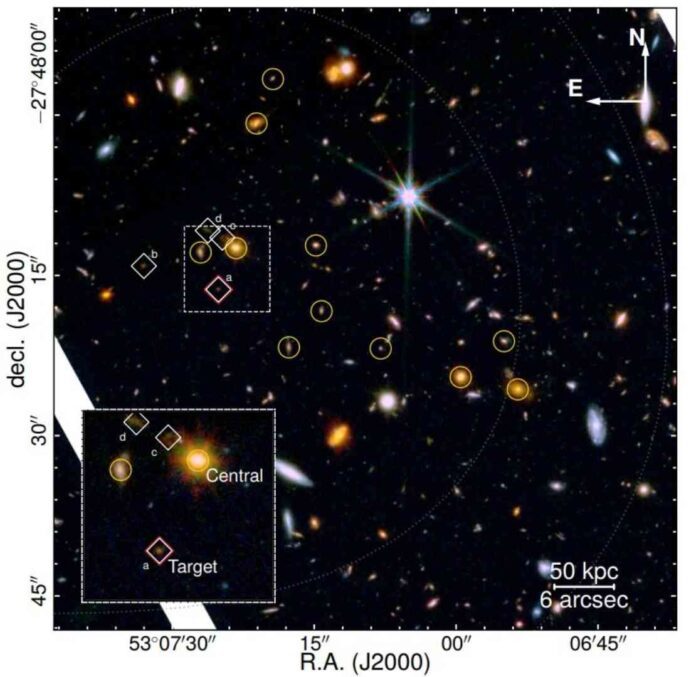A new quiescent galaxy has been discovered by an international team of astronomers through their analysis of data from the JWST Advanced Deep Extragalactic Survey (JADES). Designated as JADES-GS+53.12365-27.80454, this newfound galaxy holds the distinction of being the least massive quiescent galaxy ever detected at a high redshift. The research detailing this groundbreaking finding was published on July 17 in the arXiv preprint server.
Massive quiescent galaxies, which have ceased star formation, are believed to be potential progenitors of giant elliptical galaxies. Understanding these objects and their role in the process of galaxy evolution is vital for advancing our comprehension of the universe.
The discovery was made using the James Webb Space Telescope (JWST) as part of the JADES survey, with Lester Sandles from the University of Cambridge, U.K., leading the team of astronomers.
In their published paper, the researchers explained, “We have presented deep JWST/NIRCam and NIRSpec observations of JADES-GS+53.12365-27.80454, a compact quiescent galaxy at z = 2.34, identified through its spectral break at 1.25 µm and the absence of emission lines.”
JADES-GS+53.12365-27.80454 was found to have a stellar mass of only 950 million solar masses, making it the smallest high-redshift quiescent galaxy ever observed. Remarkably, this galaxy has remained quiescent for an impressive duration of 600 million years, with its mass-weighted average stellar age estimated to be between 0.8 and 1.7 billion years.
The researchers’ observations suggest that JADES-GS+53.12365-27.80454 has a different structural makeup compared to more massive galaxies at a similar redshift, hinting at unique evolutionary processes. They deduced that the peak of its star-formation activity occurred approximately 500 million to 1 billion years before the observational campaign.
Additionally, the team identified an overdensity of galaxies surrounding JADES-GS+53.12365-27.80454, including three spectroscopically confirmed, massive, and old galaxies. One of these massive systems lies at the center of the overdensity, positioned just 4 arcseconds away from JADES-GS+53.12365-27.80454.
According to the researchers, these findings, combined with the point-spread function-matched photometry showcasing an inverse color gradient with radius, suggest an environment-driven quenching of JADES-GS+53.12365-27.80454.
They concluded by stating, “This suggests the low-mass galaxy was quenched by environment, making it possibly the earliest evidence for environment-driven quenching to date.”
The team emphasized the need for further investigation of JADES-GS+53.12365-27.80454, advocating the use of ground-based surveys such as the MOONS Redshift-Intensive Survey Experiment (MOON-RISE) and targeted surveys with JWST to gain a more comprehensive understanding of the quenching processes affecting this galaxy and other similar systems under the influence of their environments.
Reference:
Lester Sandles et al, JADES: deep spectroscopy of a low-mass galaxy at redshift 2.3 quenched by environment, arXiv (2023). DOI: 10.48550/arxiv.2307.08633
